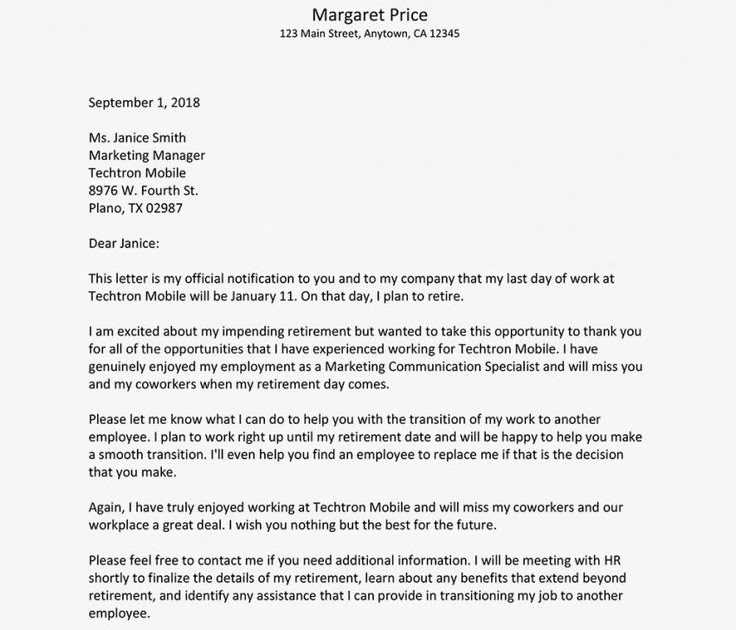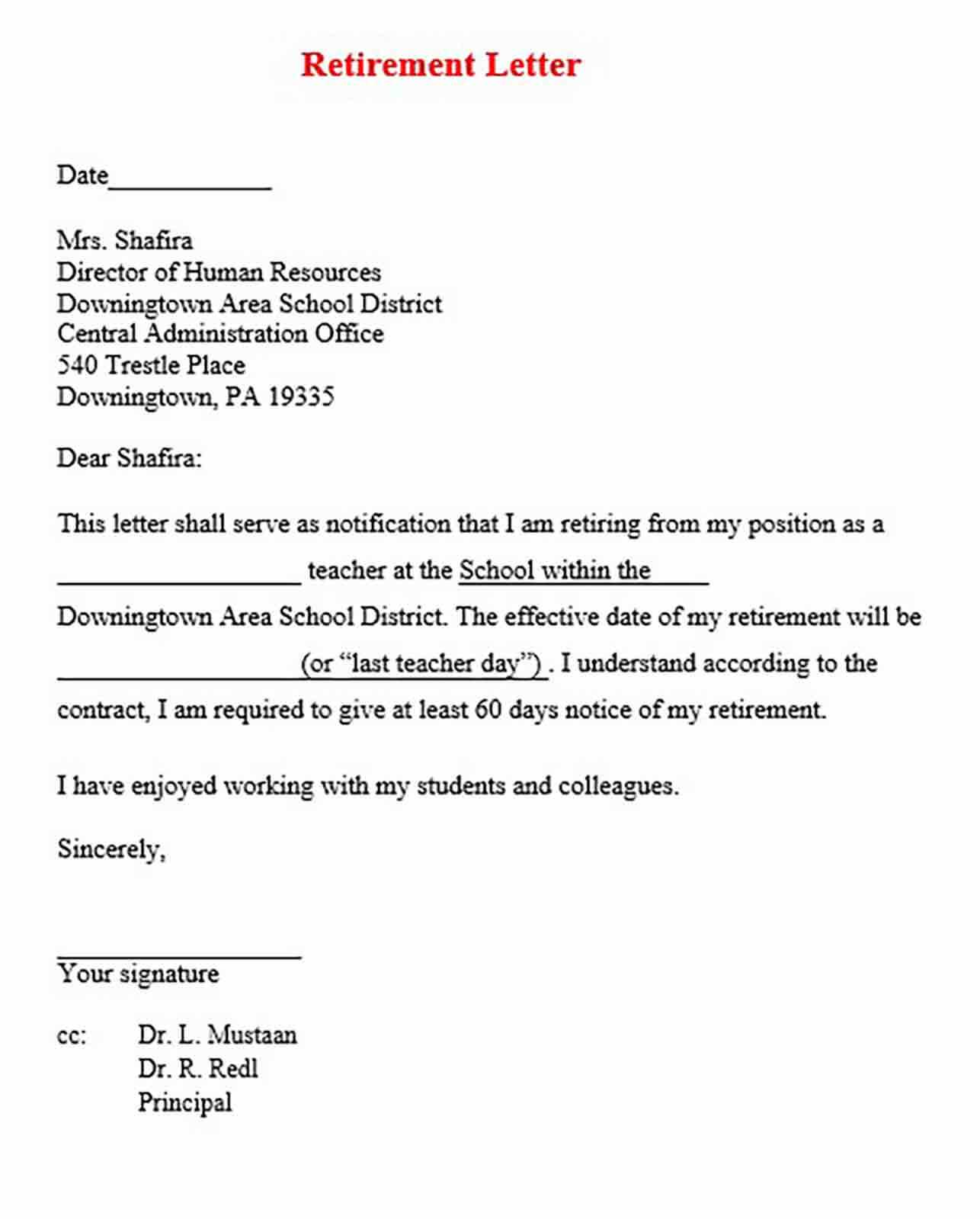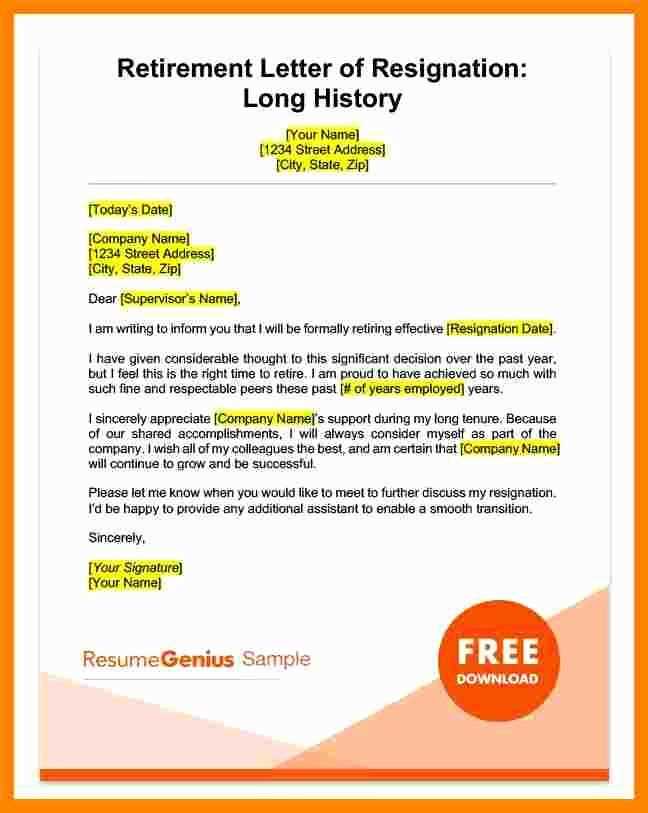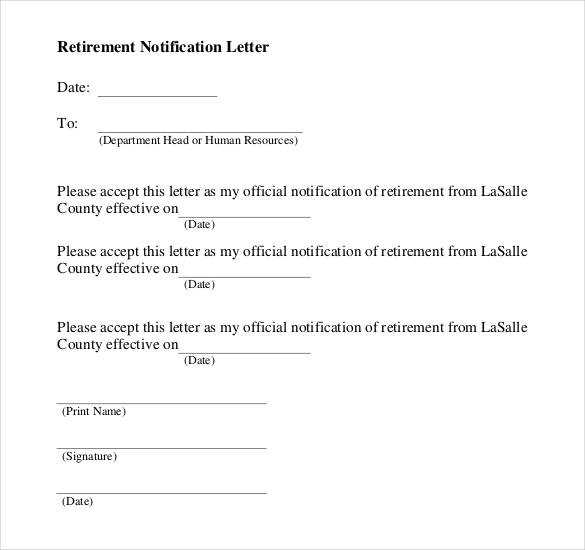Retirement Notification Letter Templates for a Smooth Transition

Making the decision to step away from your career is a significant moment in life. Whether you’re transitioning to a new chapter or enjoying well-earned time off, communicating your intention to leave is an important step. A formal announcement helps ensure clarity and smooth transitions within your workplace.
Crafting a clear, concise, and respectful message is essential in these situations. It’s important to express gratitude and maintain professionalism while providing all necessary details. The right approach can help preserve positive relationships and leave a lasting impression.
In this section, we’ll explore how to structure your farewell message effectively, ensuring that your departure is handled smoothly and professionally. With the proper guidance, you’ll be able to craft an announcement that reflects your gratitude and respect for your colleagues and organization.
Understanding Retirement Letter Basics

When it comes time to announce your decision to step away from your professional duties, it’s crucial to communicate this intention in a thoughtful and structured way. A well-crafted message ensures that both you and your organization can transition smoothly. The key is to maintain professionalism while also expressing gratitude for the time spent within the company.
There are several essential elements that should be included in this type of communication to make it clear and respectful. These are some of the most important points to keep in mind:
- Clear Intent: Be direct about your decision to leave. There should be no ambiguity about your intention.
- Gratitude: Acknowledge the opportunities, growth, and experiences gained while with the organization.
- Timeframe: Include your last working day to give the company time to plan for your departure.
- Offer to Assist: Mention your willingness to help with the transition or provide support during the handover period.
It’s important to balance formal tone with warmth. While you want to maintain a professional demeanor, you should also reflect the positive nature of your departure and leave a door open for future interactions. Keeping your message respectful and appreciative will contribute to a lasting positive impression.
Structure of a Professional Resignation Notice

When informing your employer about your decision to leave, the structure of your communication plays a key role in conveying professionalism and respect. A well-organized message not only clarifies your intention but also ensures that both parties understand the next steps for a smooth transition. This communication should be concise, direct, and composed in a way that reflects your appreciation for the time spent with the company.
The basic structure of such a message includes a few critical components:
- Opening Statement: Start with a clear and straightforward announcement of your decision to leave, specifying the effective date of your departure.
- Expression of Gratitude: Show appreciation for the opportunities and experiences provided during your time with the organization.
- Details of the Transition: Offer to assist with the handover of duties or to help train a replacement, ensuring a smooth transition.
- Closing Remarks: End on a positive note, expressing hope for future connections or collaboration.
By following this format, you ensure that your message is clear, respectful, and appreciated by your employer, leaving a lasting, positive impression as you move on to new opportunities.
When to Submit Your Retirement Letter

Deciding on the right time to inform your employer about your decision to leave is crucial for a smooth and professional transition. Giving enough notice allows your company to make necessary adjustments and prepares your colleagues for the upcoming changes. Timing your announcement carefully ensures that both you and the organization have ample time to plan the next steps effectively.
Standard Notice Periods
Most organizations expect a notice period of at least two weeks, though this may vary depending on the company’s policies or the nature of your role. It’s important to review your employment contract or discuss the ideal time frame with your HR department to ensure you meet the expectations set by your organization.
Consider Your Circumstances

If your role involves significant responsibilities or long-term projects, providing more notice–such as a month–may be more appropriate. This gives your employer more time to manage the transition, find a replacement, and complete ongoing tasks. Additionally, consider any personal factors or plans that may influence your decision on when to step down.
How to Keep Your Message Formal
When conveying your decision to step away from your current role, it’s essential to maintain a professional tone throughout your communication. This helps preserve your relationships with colleagues and managers while ensuring your departure is viewed in a positive light. A formal approach reflects respect for the company and the people you’ve worked with, ensuring that your message is taken seriously and appropriately handled.
Key Elements of a Formal Tone
To keep your communication formal, there are several important guidelines to follow. These include using respectful language, avoiding slang, and sticking to a professional format. It’s important to strike a balance between politeness and clarity while maintaining a sense of professionalism throughout your message.
| Tip | Explanation |
|---|---|
| Use a Professional Salutation | Begin your message with a respectful greeting, such as “Dear [Manager’s Name].” |
| Avoid Casual Language | Stay clear of informal expressions or abbreviations that may seem too relaxed. |
| Be Clear and Direct | Clearly state your intention to leave, without unnecessary elaboration or emotional language. |
| Express Appreciation | Always thank your employer for the opportunities provided during your time with the organization. |
Using Proper Formatting
In addition to tone, the way your message is structured can also contribute to its formality. Keep the layout clean, well-organized, and professional. Avoid using overly creative fonts or formatting styles. Stick to standard fonts like Arial or Times New Roman and use consistent paragraph spacing for a polished appearance.
Tailoring Your Letter for Different Industries
When communicating your decision to leave your position, it’s important to customize your message based on the nature of your industry and the expectations that come with it. Different sectors have unique cultures and communication styles, which should be reflected in how you convey your departure. Tailoring your announcement ensures that it resonates with the people and environment you’re leaving behind, while also preserving professionalism.
For example, in more formal industries such as law or finance, your message should maintain a highly professional tone with an emphasis on respect and gratitude. In creative fields like marketing or design, you might incorporate a more personable tone, while still keeping the content professional. Adjusting your approach can help you maintain strong relationships and leave on the best terms possible.
Here are some ways to adapt your approach for different fields:
- Corporate/Legal/Financial: Use formal language and structure, focusing on appreciation for the opportunities and expressing gratitude for the experience gained in the role.
- Creative/Design/Marketing: You can be slightly more casual, using a friendly yet professional tone, but still ensure that you express sincere thanks and offer assistance during the transition.
- Education/Non-Profit: Acknowledge the meaningful work you’ve done, emphasize the impact on your professional and personal growth, and express gratitude for the organization’s mission.
- Tech/Startups: Acknowledge the fast-paced, dynamic environment, express appreciation for the innovation and challenges, and offer help with any transitional tasks.
By understanding the culture of your industry and adjusting your tone accordingly, you ensure that your departure is viewed positively, no matter the sector.
Managing Your Last Days After Retirement Notice
Once you’ve communicated your decision to leave your position, the final days at work are crucial for ensuring a smooth transition. How you handle this period can leave a lasting impression and help maintain strong relationships with your colleagues and employer. This phase is an opportunity to wrap up your responsibilities, assist with the handover process, and ensure that any ongoing projects are completed or transitioned effectively.
During these last few weeks, it’s important to stay focused and engaged, continuing to show the same level of professionalism and dedication as you did throughout your career. This will not only ensure a positive final impression but also demonstrate your commitment to the team and the organization, even as you prepare to move on.
Here are some key steps to manage your final days effectively:
- Finish Outstanding Tasks: Complete as many projects and tasks as possible, and ensure your work is organized for a smooth handover to your successor.
- Assist with Transition: Offer help to colleagues or a new hire taking over your responsibilities. Provide clear instructions and any necessary guidance to ensure a seamless transition.
- Communicate with Your Team: Keep your team informed of your progress and remaining tasks. This will help them stay on track and maintain productivity in your absence.
- Show Appreciation: Take time to thank your colleagues and supervisors for their support and collaboration throughout your career. A simple thank you can go a long way in leaving a positive impression.
Managing your final days effectively will help ensure that you leave on a high note and preserve valuable relationships that could benefit you in the future.